Examination
Ignition coil primary circuit
1. Disconnect the electrical connector from the ignition unit. Check for corrosion and damage, then reinsert.
2. Install a 12 volt bulb in the circuit between the TACH coil terminal and "weight" engine (see picture).
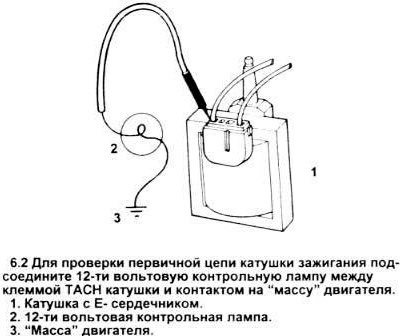
3. Turn over the engine.
4. When a flashing light appears or if the light is dim, see paragraph 7.
5. If the light goes out or is too dim, see paragraph 16.
6. Remove a control bulb.
Ignition Coil Primary Resistance
7. Turn the ignition key to position "turned off".
8. Disconnect the electrical connector of the ignition coil, check it - contamination, corrosion, damage are possible.
9. Measure the resistance between the primary terminals of the coil (see picture).
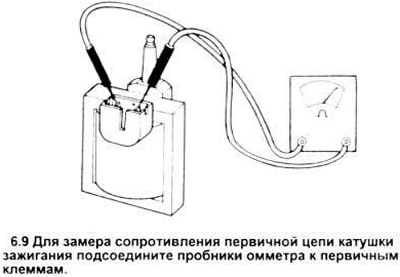
10. If the obtained resistance is within the specification, go to paragraph 12.
11. If the resistance obtained is less or greater than specified, replace the ignition coil (paragraphs 49 to 52).
Resistance of the secondary circuit of the ignition coil
12. Measure the resistance between the negative primary terminal and the secondary terminal of the ignition coil (see picture).
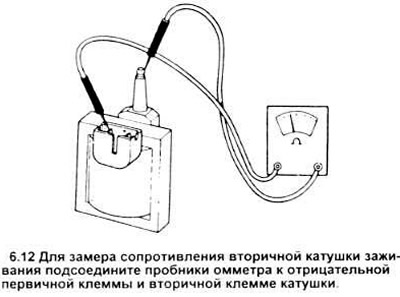
13. If the resulting resistance value is within specification, go to paragraph 25.
14. If the resistance value obtained is less or greater than the specification, replace the coil (paragraphs 49 to 52).
15. Reconnect the wires to the ignition coil.
Electrical conductivity of the primary circuit of the coil
16. Disconnect the electrical connector from the ignition module. It may be dirty or damaged.
17. Connect a negative wire of the voltmeter to the basis of the distributor.
18. Measure the battery voltage and note the value.
19. Connect the positive lead of the voltmeter to the small pin (nail), inserted into the electrical connector block 2 (see picture).

Caution: do not lock the pin on "mass".
20. Turn the ignition key to position "included" and measure the voltage at the electrical connector 2.
21. If the measured voltage is 90% of the battery voltage, proceed to check the wiring system (paragraph 25).
22. If the measured voltage is less than 90% of the battery voltage, go to paragraph 35.
23. Turn off the ignition.
24. Remove the pin from the electrical connector.
Wiring
25. Disconnect the electrical connector from the ignition module. Check for dirt, cracks, corrosion, damage.
26. Disconnect the wire from the S terminal of the starter relay.
27. Connect the negative lead of the voltmeter to the base of the distributor.
28. Measure the battery voltage and note its value.
29. Using a work table, measure the voltage at the terminals of the electrical connector by connecting the positive wire of the voltmeter to a small pin inserted into one of the sockets of the connector at each measurement; while the position of the ignition key must be in the specified position (see pictures).


30. If all three slots measure 90% of battery voltage, refer to EEC-IV/TFI-IV System Check in Section 10.
31. If the measured voltage is less than 90% of the battery voltage, check the wiring and connectors (see the wiring diagrams at the back of the book for the appropriate circuits). Check the ignition key - possible damage and wear (see chapter 12).
32. Turn off the ignition.
33. Pull the pin out of the connector socket.
34. Connect the wire to terminal S of the starter relay.
Primary coil voltage
35. Connect the negative voltmeter wire to the distributor base.
36. Measure and note the battery voltage.
37. Turn the ignition key to position "included".
38. Measure the voltage at the negative terminal of the ignition coil (see picture).
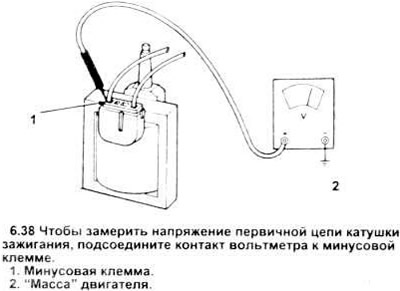
39. If the value obtained is 90% of the battery voltage, check the wiring between the ignition module and the negative terminal of the coil.
40. If the value is less than 90% of the battery voltage, then after checking the wiring between the module and the coil, go to paragraph 42.
41. Turn off the ignition.
Ignition coil supply voltage
42. Disconnect the ignition coil wiring.
43. Connect the negative lead of the voltmeter to the base of the distributor.
44. Measure the battery voltage.
45. Turn on the ignition.
46. Measure the voltage at the positive terminal of the ignition coil (see picture).

47. If the measured voltage is 90% of the battery voltage, check the coil connector and terminals - there may be dirt, damage or corrosion.
If the connector and terminals are clean, replace the ignition coil itself (paragraphs 49 to 52).
48. If the voltage value obtained was less than 90% of the battery voltage, check and repair the circuit between the coil and the ignition switch (see wiring diagrams at the end of the book). Check the ignition key for damage and wear (see chapter 12).
Replacing the ignition coil
49. Disconnect the cable from the negative battery terminal.
50. Disconnect the high voltage wire of the coil, then disconnect the primary electrical connector from the coil (see pictures).

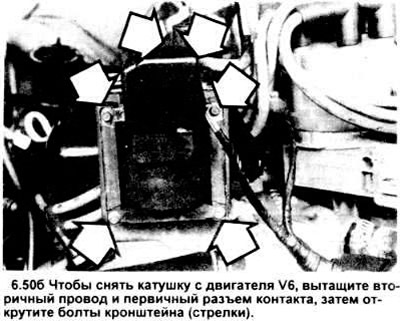
51. Unscrew the bracket bolts and disconnect the coil.
52. Installation is carried out in the reverse order.
Visitor comments